
Rating:AAAAA
Key Words:World Cultural Heritage,Spring Outing,
Mutianyu Great Wall is one of the most well-known Great Wall sections in Beijing and played an important role among the Ming Great Wall sections
Description
Mutianyu Great Wall is one of the most well-known Great Wall sections in Beijing and played an important role among the Ming Great Wall sections. This section connects the north Gubeikou and the west Juyongguan and served as a key fortress that guarded Beijing in the past times. Zhengguantai (正关台) and Dajiaolou (大角楼) are the famous spots of it. More importantly, the wall in this section has been well protected and can better expose the old flavor of the Great Wall.
Despite the hundreds of buses that visit daily, the Great Wall at Mutianyu is not as crowded as the nearby Badaling or Juyongguan sections of the Wall. Mutianyu's 2.5 kilometer stretch of the Wall allows you to walk for more than an hour as you explore 22 watchtowers and the valley on both sides of the Wall. During the late afternoon, or in poor weather, you often might find yourself alone with only the sound of the wind to keep you company. Travel back in time and see the Wall as it was when it was built hundreds of years ago.
The wall was first built in the Northern Qi Dynasty (550 - 557). In the Ming Dynasty (1368 - 1644), Tan Lun and Qi Jiguang, two famous patriotic generals, rebuilt it in order to strengthen its defensive potential when they guarded the strategic pass. It served as the northern protective screen, guarding the capital and imperial mausoleums for generations. Reconstruction began in 1568 on 1000km of the Wall including Mutianyu. Responsibility was given to Qi Jiguang, a general who had built his credentials fighting Japanese pirates, and who took his responsibilities as a builder very seriously. Construction continued for many years, as the fortifications were built up with solid granite blocks, and included the construction of some of the larger defensive towers.
There are 22 watch towers distributed at close intervals along the wall. They are located not only in the main wall but also at the distinctive "branch cities". Branch cities are built on the hill ridge against the inner or outer side of the wall. They measure from several yards to dozens of yards across. On the northwest over 3,281-feet hills, lies a section of the wall called "Ox Horn Edge". On the steep and lofty peaks, there are two walls named 'Flying Eagle Flies Facing Upward' and "Arrow Lock". What is more rarely seen on the southeast side is a general gateway platform guarded by three watch towers together. In locations of strategic importance, batteries are set up to reinforce the defense capabilities. Mutianyu really deserves to be the archetype of the ten thousand li Great Wall. Besides its strategically important location and compact layout, the Mutianyu Great Wall is also famous for the breathtakingly beautiful scenery. Woods cover over ninety-six percent of the total scenic area. The wall presents different aspects of beauty in the four seasons. Flowers bloom all over the mountains in spring. Grasses dress the hillside green in summer. Trees are laden with sweet fruits in autumn, and especially in October, leaves are turning red or yellow, touching the mountain tops with gold. In winter, the wall is covered by snow, making it seem more magnificent. The pine trees around the wall are well-known. There are more than 20 pines over 300 years old and about 200 pines over 100 year old. Besides, spring water at the foot of the wall tastes pure and fragrant, much appreciated by visitors. The Great Wall at Mutianyu (慕田峪长城) is located in Huairou District, about 80 km north of downtown Beijing.
Features: Built mainly from granite, the pass at Mutianyu is an appropriately unique section of the Great Wall. 7 to 8 meters high, and 4 to 5 meters high with crenellations on both sides of the Wall, the section of the Wall at Mutianyu stretches for over 2 kilometers. Matching its military importance, the Mutianyu Great Wall has 22 watchtowers built at almost 100 meter intervals. This number of towers is much more than would be expected along the Wall, and is also highlighted by the particular form and structure unique to this section. The Zheng Guan Tai gate stands with three connected watchtowers, with the center tower rising above the flanking structures. While each tower has its own gate, the main watchtower gate is on the east side of the building, which is quite unusual. Other unique features in this section include the "Tail Wall" which stretches out perpendicular to the Wall along a ridgeline for stronger defensive positioning, and another perpendicular extension on the other side of the Wall. Invading nomads would use the ridgelines as they marched, to avoid being caught unawares in the brambles and trees below, and the positioning of the Great Wall along the ridgeline and these adjoining tail walls are recognition of the importance of this high ground.
Geographical Location
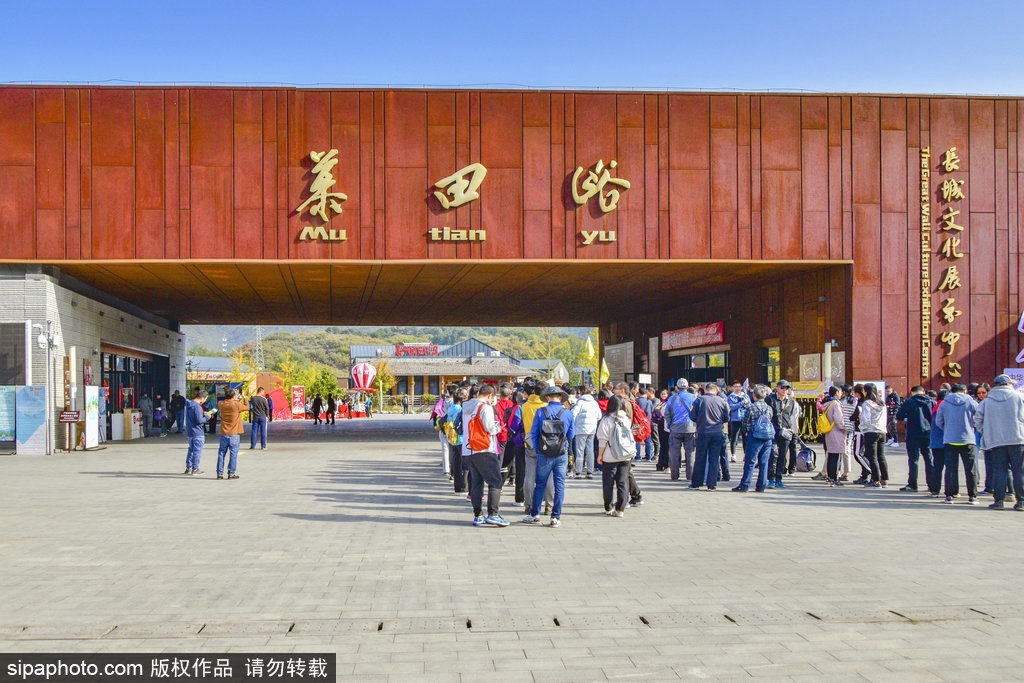
The Mutianyu Great Wall is located in Mutianyu Village in Huairou district, with Gubeikou to the east and Huanghuacheng and Badaling to the west It's also not far from Juyong Pass, Zijing Pass, Daoma Pass. As the poem goes, " west of Bohai fairyland, east of purple and green Juyong, so the steep and towering terrain makes it possible to preserve Mutianyu as the most well-kept and typical portion of the Great Wall which dates back to the Ming Dynasty. It was also a great military barrier and protection for the capital and Imperial Tombs thus it has been a hotly contested spot since ancient time.
Natural Environment
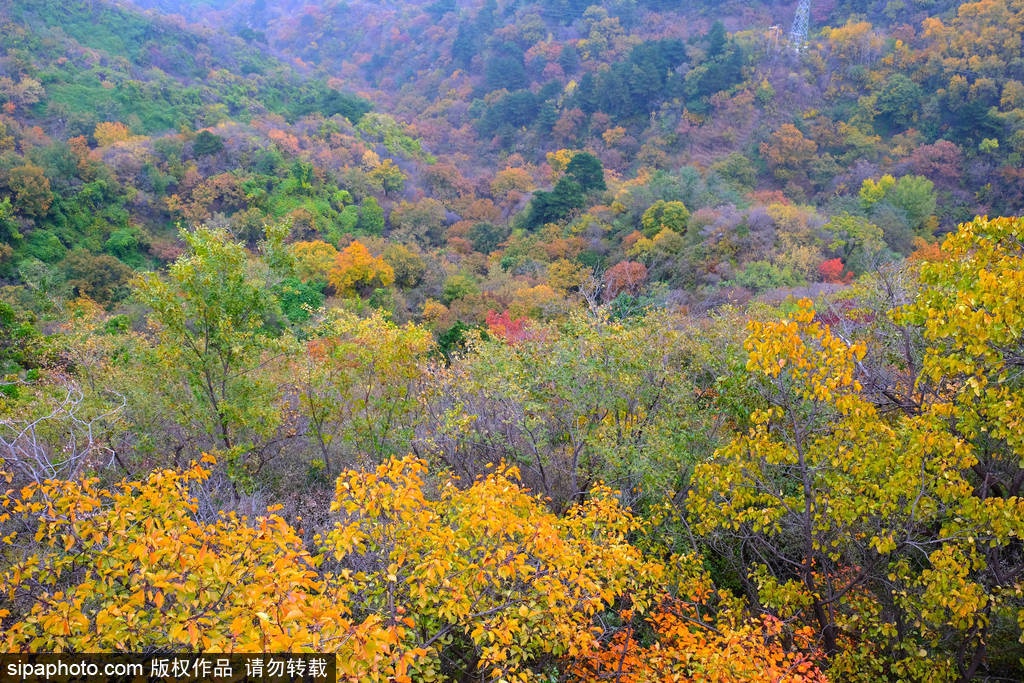
The Mutianyu Great Wall has four distinct seasons, and tourism activities can be carried out all year round. With ranges of mountains surrounded, the vegetation coverage rate has reached more than 96%,and the annual average temperature is 11.9 degrees Celsius. The warm and humid climate helps keep an abundant vegetation coverage, so the part of the Great Wall is nestled in the green mountains and rivers. The ancient atmosphere and the beauty of nature is well blended into one harmonious whole, leading to the reputation the unique beauty of the Mutianyu Great Wall among the ten thousand li Great Wall There are over a thousand old trees of more than a hundred years old. From the beginning of March on, apricot trees, peach trees, Rhododendron and others start to bloom one after another all over the mountains; into the summer, you cypress trees, red maple, oak, and chestnut trees, yellow apricot trees and golden pear an aera, ine trees and purple pear and plum trees. All different colours of leaves intertwine with the white colour of branches, forming a natural painting: in winter, snow mountains glow and gleam, presenting a picturesque Northland scenery.
Landscape features
1.Zhengguantai
Also known as Mutianyuguan, or Three Buildings, built in the Ming Yongle 2nd year(AD 1404).The three watchtowers are lined up together, two layers. The one in the middle is relatively big and the ones on the side are small. Each floor of the three watchtowers is connected, forming the style of the main hall in the centre and the rooms are on the side, which is very rare in the entire construction of the Great Wall
2. Dilou Towers
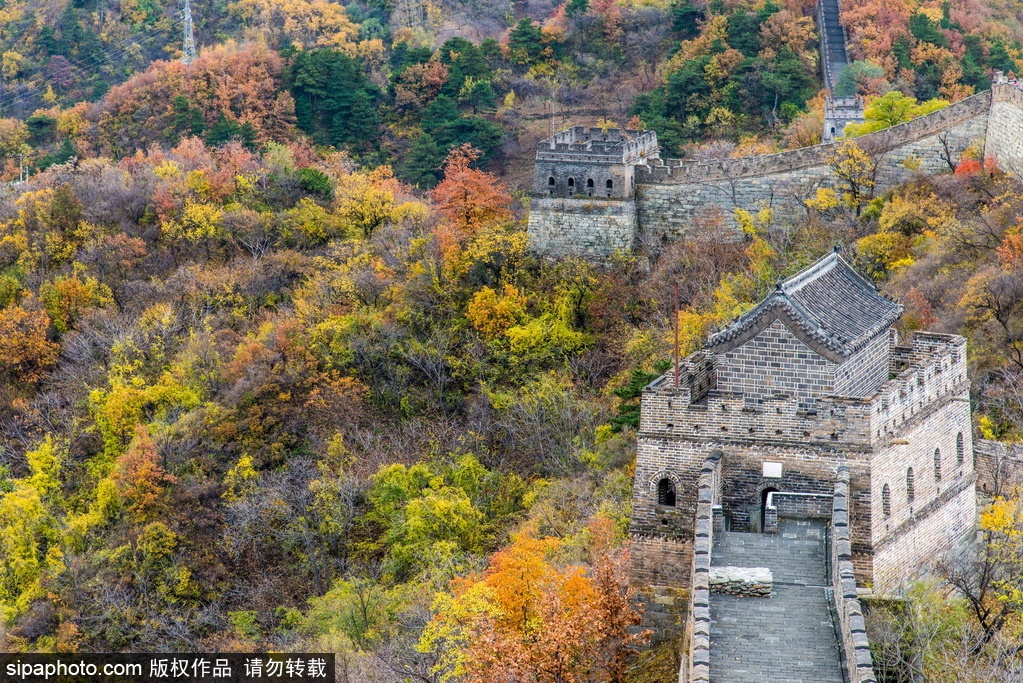
There are many Dilou towers in the Mutianyu Great Wall. There are four Dilou Towers from the 1st Muzi Terrace (Dajiao Tower)to fourth Muzi Terrace(Zhengguan Tower)within less than 500 meters; from the 1st Muzi Terrace to the 20th Muzi Terrace, there re 25 buildings including watchtowers, battlements and wall units, and bedrooms within 3000 metres. It's also unusual to see a Dilou tower every one hundred metre in the Great Wall
3. Double Crenels
The Mutianyu Great Wall has crenels on both sides of the Wall. The rest of the Great Wall all has crenels on the outer wall, while the Mutianyu stretch of the Great Wall has crenels on both sides that soldiers can hght against the enemy from both sides. This means the Mutianyu Great Wall is an important strategic position in battle in history
4. Branch City
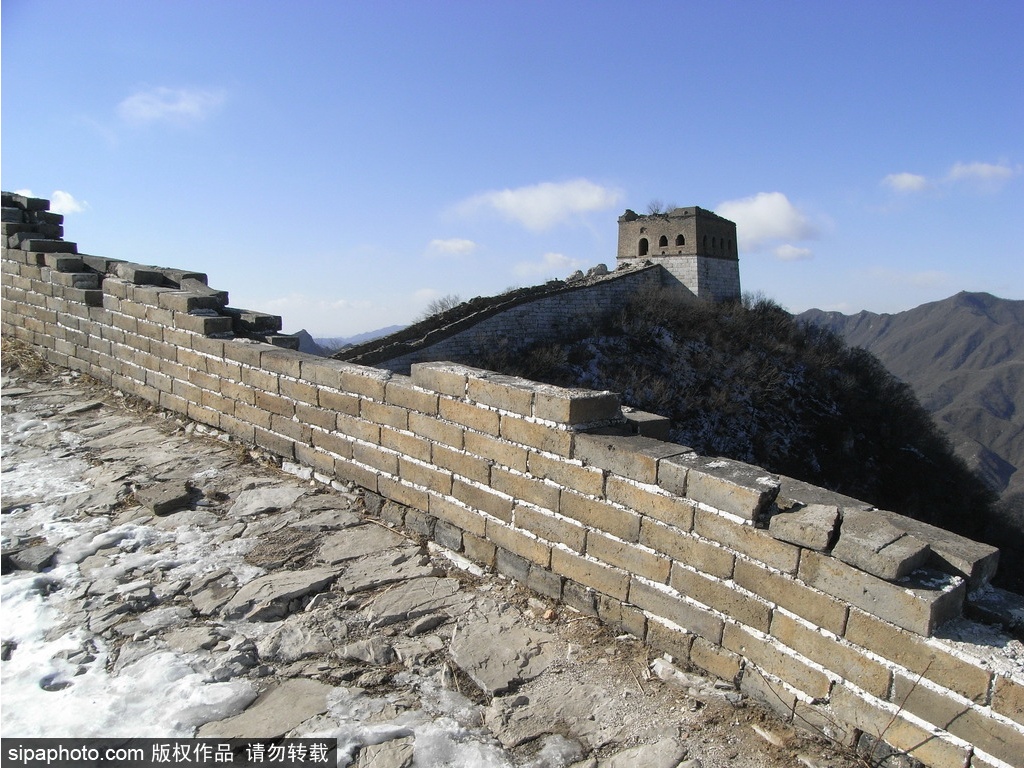
There are both outside stretch and inner stretch of Wall in the Mutianyu Great Wall. A so-called Branch City refers to a branch stretch built and connected to the main stretch of the Wall. The outside stretch connects the 11th Muzi Terrace Wall: and the inner stretch is called Bald Tail Side which extends to the south from the Big Horn Tower.
5. Ox Horn Edge
The Mutianyu Great Wall wind its way from the north to the west. At the No 20 Watchtower, the Wall climes straight up the hillside to the north high cliff top, 1039 meters high, from the flat south, meeting a tower at the top of the mountain and then turning along the cliff edge straight down through the valleys along the opposite ridge. Then it winds its way down westward. With its twists and turns, this resembles a horn, vigorous and firm. known as the " Ox Horn Edge”.
6. Flying Eagles face up
One side of the Great Wall is cliff, and the other side is a steep of 70 degrees. This stretch of the Wall climbs to the peak from one side of a cliff and drops about 10 metres to the other side almost vertically do Each step is only a few fingers wide, and one can hardly ft in a foot. That is why it is also described as Flying Eagles face up, meaning it's very lofty and cragged.
Activity Items
1. the first Cable Car of the Great Wall
The full length of the cable line is 723 meters, and it's 640 meters high at the end. There are 58 cable cars which open and close automatically. The cable can hold 1800 passengers/ hour one way in total. The operation system is fully automatic and passengers with disabilities can also get on and off cable cars easily and safely at the station. It is comfortable, convenient and fast, so it s gained the name of "the first cable car of the Great Wall
2. Speed Slide
The slide is a new sport, also for fun, commonly known as "Land Sled. It utilizes the principle of acceleration of gravity to drive the pulley and tramcars down the mountain dive, full of thrill and excitement. but it's safe and comfortable at the same time. You' lI like flying or driving a race car. Besides, the speed slide has a brake device, which can both speed up and slow down. So it's good for both the young and the old. This stainless steel equipment is made by a Germany company, called Wiegand, and it has a total length of 1580 meters. This speed slide, can carry you safely from the mountain top to the foot of the Great Wall.
3. The Great Wall Culture Exhibition Center
The Mutianyu Great Wall Cultural Exhibition Center is located in the Mutianyu Great Wall comprehensive service area with a simple and elegant design. It covers an area of 1207 square meters, and fully demonstrate the profound cultural heritage of the Mutianyu Great Wall.
History
First built in the mid-6th century during the Northern Qi, the Mutianyu section is older than the Badaling section of the Great Wall. During the Ming dynasty, under the supervision of Marshal Xu Da (a.k.a. Zhongshan Wang, Zhongshan, or Xu Zhongshan), construction of the present wall began, building over the previous wall. In 1404, a pass was built in the wall. In 1569, the Mutianyu Great Wall was rebuilt and till today most parts of it are well preserved. The Mutianyu Great Wall has the largest construction scale and best quality among all sections of Great Wall.
In 1568, the Longqing Emperor appointed Qi Jiguang as governor and military administrator of Jizhen, Changzhen and Baoding to help train the guards in the area. Qi Jiguang helped to maintain the 2000-li section of the Great Wall, which was finished in 1572. Qi Jiguang, upon noticing that the wall had no abutments, suggested the installation of abutments to officials. His suggestion was approved.
In 1983, the State Council of the People's Republic of China approved the restoration of the Mutianyu Great Wall. In 1985, the Huairou District local government established the management of the Mutianyu Great Wall Tourist Area under the leadership of Mutianyu village. The area was opened to select tourists in 1986, and was chosen to be one of Beijing's 16 scenic spots in the same year. In 1987, the Great Wall was selected as a UNESCO World Heritage site. In 1988, the tourist area was opened to all visitors. In 1992, Mutianyu was rated as the best tourist spot in Beijing
The scenic area has two entrances: south entrance and north entrance. One can start the visit from either of it.
Hiking:
Go through the North Entrance, you will hike up to No. 10 or No. 8 Watchtower.
Go through the South Entrance, and you will arrive at No. 8 or Zhengguan Terrace (No. 6 Watchtower).
Upon arriving up there, you can hike either northward or southward. The northward route between No. 14 watchtower and No. 23 watchtower has the most beautiful scenery, while the southward route contains the grand Zhengguan Terrace and Big Corner Tower.
Cable Car:
Apart from hiking, you may also take a cable car up to the No. 14 Watchtower. The lower station is near the North Entrance, so you can easily find it. It is safer and smoother than the toboggan, even suitable for children and senior visitors.
Chairlift / Toboggan:
You can also take toboggan down from Zhengguan Terrace (No. 6 Watchtower) near the South Entrance. It is very exciting to take the toboggan, and a great choice for young people.
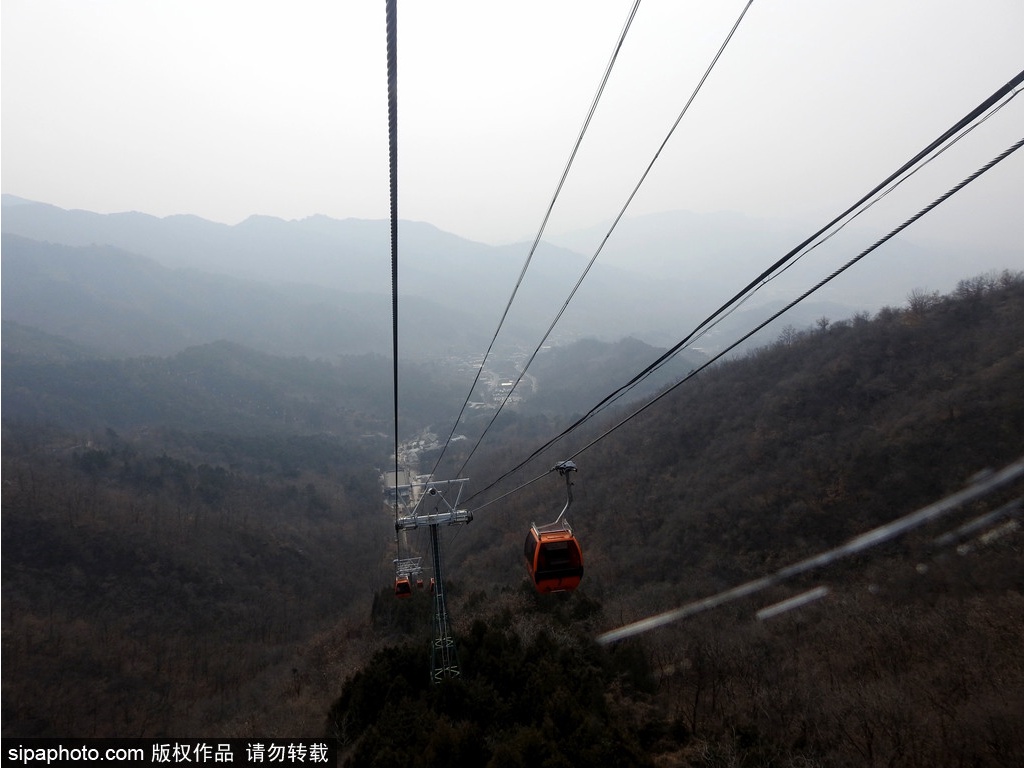
Ways to get to the Great wall:
Option 1: Expert Guided Day Tour in English
Join our fully guided Mutianyu small group tour in mini group size with maximum 9 members, with pick up & drop off service from your hotel in Beijng, to tour Mutianyu Great Wall, and highlights of Beijing including the Forbidden City, Tian’anmen Square, Bird’s Nest, and Nanluoguxiang Hutong.
Option 2: Dongzhimen Tourist Bus Line
From Dongzhimen Wai Bus Station, one can take direct Dongzhimen tourist bus line which departs at 08:30. The duration is 1.5 - 2 hours and the ticket fare is CNY 30. Subway line 2 or line 3, bus line 359, 915/ 915 express, 935/ 935 express, 942 or 966 is available to reach Dongzhimen wai bus station.
Option 3: Bus line 916 Express + h23, h24, h35 or h36
It is the popular way to reach Mutianyu from Dongzhimen Public Transport Hub. One need to take bus line 916 express to Huairou North Avenue (Huairou Beidajie) Station. And then change to take h23, h24, h35 or h36 to Mutianyu Roundabout. Afterwards, walk about 3 kilometers (1.9 miles) to the ticket office of the scenic area. The total single journey time is around 2-2.5 hours.
Option 4: Qianmen Tourist Bus Line
This bus line runs directly to Mutianyu Great Wall from Qianmen Tourism Distribution Center. The bus departs at 08:30 from Qianmen and 09:00 from Shaoyaoju; the total travel time is 2 - 2.5 hours with the ticket fare of CNY30.



